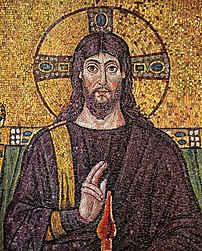Everett Cattell: Communication As Witness (pt. 4)
Series contents | Intro | Part Two | Part Three | Part Four | Part Five
 Image via Wikipedia
Image via Wikipedia A good theological understanding of communication begins with the incarnation and John 1; Quaker Missionary Everett Cattell covers this thoroughly before moving onto a more in depth discussion of what it means for the Christian missionary to communicate, or witness for/to the Gospel. Maturion in the Greek means to bear in mind, or to remember. As its usage progressed throughout history it became a legal word having to do with establishing facts in court. Later it was broadened even further, from giving evidence concerning observable facts to giving witness to ones views, truths, or convictions (Christian Mission, 1981:58). It is this latter definition that Cattell picks up on.In early Christianity, maturion developed into a term identifying witnesses who died for their faith and is where our word martyr comes from. Cattell, while happily acknowledging the moving power of such a commitment to faith, sees this linguistic connection as having trivialized the witness of the daily living out of one’s faith a feature of the Gospel he wants to recover (58). He turns to the new testament to give draw a clearer picture of what witness means.
For Cattell, maturion in the NT works together with three other concepts: kerygma (proclamation), diakonia (service), and koinonia (fellowship). These three concepts help to flesh out the role of the missionary witness and his or her task in sharing the Gospel. First, kerygma, the message is delivered by the herald the one who has been entrusted the message. The herald has a self-assured voice that is heard and operates with a sense of authority bestowed upon him or her (60). Second, diakonia, the witness of the missionary also works as service to a sense of need. This is based off of “You shall love you neighbor” (Lev. 19:18). Service should never work out of a “bait and switch” mentality, this is not how Jesus did it in the Gospels, this is not how the church should do it (67). For Jesus, his …healings were a sheer demonstration of the love of God, and this is the mode the church ought to work out of. Third, koinonia, witness also operates as a “fellowship of the repentant.” This is the assembly who work in unity (73). Cattell uses koinonia as a contrast to the problems he sees in the institutionalized church. Throughout church history koinonia faded and was replaced by the structured church. This structured church view finally was equated with the kingdom of God under Constantine (74). The koinonia of the repentant is the remedy to institutionalization.
However, Cattell is not arguing to throw out the institutional church altogether, or even abandon it, what we need is to recover the koinonia within these institutions, as well as outside them, recognizing that this move may render some of our structures irrelevant. To develop this just a bit further Cattell gives us three features to the biblical notion of koinonia:
- Mutual Acceptance: the church becomes an accepting body (77). This acceptance means the church is to be open to one another regardless of race or color, denomination, etc.
- Mutual Edification: growing together in maturity, being open to confess our sins to one another, be honest with one another, etc.
- Organic Unity: there are real differences between men, women, black, white, young and old but we are all one in Christ Jesus.
Cattell argues that through this process of witness, The repentant now follow the King, get their directions, and their life style, and their ethics, not from the surrounding culture but from the kingdom of God in which they have begun to life (75).
The next post on Cattell will be my conclusion.
![Reblog this post [with Zemanta]](http://img.zemanta.com/reblog_e.png?x-id=eab0d907-31ee-40a0-9ffd-180fa6c7b374)